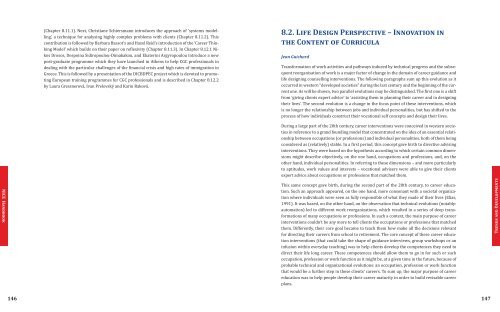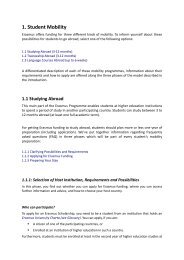<strong>NICE</strong> Handbook◆◆Pr<strong>of</strong>essionalization <strong>of</strong> career guidance and counselling:The practice <strong>of</strong> career guidance and counselling doesn’t have a very old tradition, as for examplethe medical pr<strong>of</strong>essions do. Different ‘career pr<strong>of</strong>essions’ have developed from diversebackgrounds over the past century, all in all due to an increasing complexity <strong>of</strong> work-relatedquestions which individuals, organisations and societies have to deal with. CGC pr<strong>of</strong>essionalswork in a great diversity <strong>of</strong> fields, e.g. as social workers, for public employment agencies, aspersonnel developers in corporations, or as freelance counsellors. Through the growing need<strong>of</strong> CGC pr<strong>of</strong>essionals in all spheres <strong>of</strong> our societies, and with a growing awareness that CGCservices need to be <strong>of</strong> high quality in order for them to fulfil what they promise, a pr<strong>of</strong>essionalizationand growing-together in our field can be perceived (Chapter 2). More and more associations<strong>of</strong> CGC pr<strong>of</strong>essionals are being founded, and the provision <strong>of</strong> high quality CGC servicesand the competence <strong>of</strong> practitioners is becoming an important topic not only politically, butalso among pr<strong>of</strong>essionals and in CGC organisations.◆◆Emergence <strong>of</strong> an academic discipline in career guidance and counselling:How multidisciplinary the field <strong>of</strong> career guidance and counselling is, can easily be understoodwhen looking at the great variety <strong>of</strong> academic disciplines involved in the <strong>NICE</strong>: Among us arevocational and organisational psychologists, educational and social scientists, anthropologists,and human resource management scholars – just to name a few <strong>of</strong> the disciplines. Manytrends are currently brining us together through, particularly the ongoing pr<strong>of</strong>essionalization<strong>of</strong> career guidance and counselling, and the need for lifelong guidance (see above): Multidisciplinary,practice-oriented <strong>training</strong>s are not only being demanded by practitioners themselves,but also by policy-makers, researchers and the diverse providers <strong>of</strong> CGC services. Similarly,multidisciplinary, practice-oriented research is being promoted to answer many <strong>of</strong> the complexquestions on how to increase and secure the quality and effectiveness <strong>of</strong> CGC services,address societal challenges, and generally gain a clearer picture <strong>of</strong> the many factors which arerelevant in regard to the CGC practice. The foundation <strong>of</strong> the ‘European Society for VocationalDesigning and <strong>Career</strong> Counseling’ (ESVDC) is indicative <strong>of</strong> this trend towards cooperative andmultidisciplinary research in our field, similarly to the multidisciplinary cooperation in <strong>NICE</strong>to develop higher education in career guidance and counselling.8.1.2. ContributionsA large number <strong>of</strong> individuals or teams have provided us with contributions to this chapter;contributions which can be distinguished along three categories. On the one hand, we have anumber <strong>of</strong> nine papers on themes or concepts for innovating degree programmes in careerguidance and counselling. On the other hand, we have three examples <strong>of</strong> innovative tools forthe CGC practice, and two examples for the development <strong>of</strong> innovative programmes for thehigher education <strong>of</strong> CGC pr<strong>of</strong>essionals. As we understand the latter two categories as examplesfor how innovative concepts can be translated into teaching, <strong>training</strong> and practice, we will firstintroduce the contributions on innovative concepts and themes, before we give a short overview<strong>of</strong> the examples for innovative tools and <strong>training</strong> approaches.Nine individuals and teams have made contributions regarding innovative themes and concepts.Almost all <strong>of</strong> them are related to various themes illustrated in the innovation framework.All contributions are relevant for the pr<strong>of</strong>essionalization <strong>of</strong> career guidance and counselling,for instance, and contribute to the development <strong>of</strong> our academic discipline. This makes it particularlydifficult to come up with a logical sequence for the different contributions. Therefore,we have decided to structure this chapter based on the NCC, well knowing that most <strong>of</strong> thecontributions also refer to several <strong>of</strong> the <strong>NICE</strong> Pr<strong>of</strong>essional Roles (NPR), if not all <strong>of</strong> them. Webegin with contributions primarily focussing on the NPR centred on working with individuals,then move on to CGC pr<strong>of</strong>essionals working with groups. The next contributions deal with CGCpr<strong>of</strong>essionals’ managerial tasks, and overall questions <strong>of</strong> pr<strong>of</strong>essionalism.Our first four contributions primarily focus on CGC pr<strong>of</strong>essionals’ work with individual clients.First, Jean Guichard will introduce the concept <strong>of</strong> life designing and suggest which competencesand level <strong>of</strong> <strong>training</strong> are needed to <strong>of</strong>fer different types <strong>of</strong> CGC services, the latter <strong>of</strong> whichfocus on working with individuals on complex career questions, and supporting them in constructingtheir identities (Chapter 8.2). The following contribution by Jacques Pouyaud looksat the role <strong>of</strong> context and action in such life designing interventions, giving special thought tothe embeddedness <strong>of</strong> individuals in their social environments (Chapter 8.3). Then, ChristianeSchiersmann introduces the concept <strong>of</strong> Synergetics and discusses how current systems andself-organisation theories can be used to pr<strong>of</strong>essionalize the interventions <strong>of</strong> CGC pr<strong>of</strong>essionals,with a particular focus on counselling activities (Chapter 8.4). Finally, Wouter Reynaert’scontribution in Chapter 8.5 introduces the concept <strong>of</strong> serendipity and discusses how the subconsciousresources <strong>of</strong> clients can be used in CGC services alongside the traditional use <strong>of</strong>‘rational’ approaches.The following contribution from Lea Ferrari, Laura Nota, Salvatore Soresi and Teresa Sgaramelladeals with the use <strong>of</strong> preventive CGC programmes (Chapter 8.6). Here, the focus shiftsaway from only working directly with (single) clients, to programmes where CGC pr<strong>of</strong>essionalswork with small and large groups <strong>of</strong> clients, or with the contexts <strong>of</strong> clients (e.g. parents). Itis followed by a contribution from Peter Weber, Johannes Katsarov and István Kiss who talkabout the increased meaning <strong>of</strong> quality considerations in the practice <strong>of</strong> career guidance andcounselling, taking a decisive look at the managerial dimension <strong>of</strong> CGC practice (Chapter 8.7).The next three contributions focus on specific questions <strong>of</strong> pr<strong>of</strong>essionalism in career guidanceand counselling. First, Hazel Reid and Barbara Bassot look at the meaning <strong>of</strong> reflexivity forpr<strong>of</strong>essional career guidance and counselling in Chapter 8.8. Next, Raimo Vuorinen and JaanaKettunen investigate how the use <strong>of</strong> ICT can and should be embraced in the CGC practice inChapter 8.9. Last but not least, Stefan Vendel gives some thought to questions <strong>of</strong> mobility andEuropeanization in regards to career guidance and counselling in Chapter 8.10.The final two chapters are dedicated to examples <strong>of</strong> innovative tools (Chapter 8.11) and <strong>training</strong>programmes (Chapter 8.12). First, Valérie Cohen-Scali provides an example <strong>of</strong> a life designinginterview approach which can be used for working with adolescents and young adultsTrends and Developments144 145
(Chapter 8.11.1). Next, Christiane Schiersmann introduces the approach <strong>of</strong> ‘systems modelling’,a technique for analysing highly complex problems with clients (Chapter 8.11.2). Thiscontribution is followed by Barbara Bassot’s and Hazel Reid’s introduction <strong>of</strong> the ‘<strong>Career</strong> ThinkingModel’ which builds on their paper on reflexivity (Chapter 8.11.3). In Chapter 8.12.1 NikosDrosos, Despoina Sidiropoulou-Dimakakou, and Ekaterini Argyropoulou introduce a newpost-graduate programme which they have launched in Athens to help CGC pr<strong>of</strong>essionals indealing with the particular challenges <strong>of</strong> the financial crisis and high rates <strong>of</strong> immigration inGreece. This is followed by a presentation <strong>of</strong> the DICBDPEC project which is devoted to promotingEuropean <strong>training</strong> programmes for CGC pr<strong>of</strong>essionals and is described in Chapter 8.12.2by Laura Gressnerová, Ivan Prelovský and Karin Raková.8.2. Life Design Perspective – Innovation inthe Content <strong>of</strong> CurriculaJean GuichardTransformation <strong>of</strong> work activities and pathways induced by technical progress and the subsequentreorganisation <strong>of</strong> work is a major factor <strong>of</strong> change in the domain <strong>of</strong> career guidance andlife designing counselling interventions. The following paragraphs sum up this evolution as itoccurred in western “developed societies” during the last century and the beginning <strong>of</strong> the currentone. As will be shown, two parallel evolutions may be distinguished. The first one is a shiftfrom ‘giving clients expert advice’ to ‘assisting them in planning their career and in designingtheir lives’. The second evolution is a change in the focus point <strong>of</strong> these interventions, whichis no longer the relationship between jobs and individual personalities, but has shifted to theprocess <strong>of</strong> how individuals construct their vocational self concepts and design their lives.During a large part <strong>of</strong> the 20th century, career interventions were conceived in western societiesin reference to a grand founding model that concentrated on the idea <strong>of</strong> an essential relationshipbetween occupations (or pr<strong>of</strong>essions) and individual personalities, both <strong>of</strong> them beingconsidered as (relatively) stable. In a first period, this concept gave birth to directive advisinginterventions. They were based on the hypothesis according to which certain common dimensionsmight describe objectively, on the one hand, occupations and pr<strong>of</strong>essions, and, on theother hand, individual personalities. In referring to these dimensions – and more particularlyto aptitudes, work values and interests – vocational advisers were able to give their clientsexpert advice about occupations or pr<strong>of</strong>essions that matched them.<strong>NICE</strong> HandbookThis same concept gave birth, during the second part <strong>of</strong> the 20th century, to career education.Such an approach appeared, on the one hand, more consonant with a societal organizationwhere individuals were seen as fully responsible <strong>of</strong> what they made <strong>of</strong> their lives (Elias,1991). It was based, on the other hand, on the observation that technical evolutions (notably:automation) led to different work reorganizations, which resulted in a series <strong>of</strong> deep transformations<strong>of</strong> many occupations or pr<strong>of</strong>essions. In such a context, the main purpose <strong>of</strong> careerinterventions couldn’t be any more to tell clients the occupations or pr<strong>of</strong>essions that matchedthem. Differently, their core goal became to teach them how make all the decisions relevantfor directing their careers from school to retirement. The core concept <strong>of</strong> these career educationinterventions (that could take the shape <strong>of</strong> guidance interviews, group workshops or aninfusion within everyday teaching) was to help clients develop the competences they need todirect their life long career. These competences should allow them to go in for such or suchoccupation, pr<strong>of</strong>ession or work function as it might be, at a given time in the future, because <strong>of</strong>probable technical and organizational evolutions: an occupation, pr<strong>of</strong>ession or work functionthat would be a further step in these clients’ careers. To sum up, the major purpose <strong>of</strong> careereducation was to help people develop their career maturity in order to build revisable careerplans.Trends and Developments146 147






